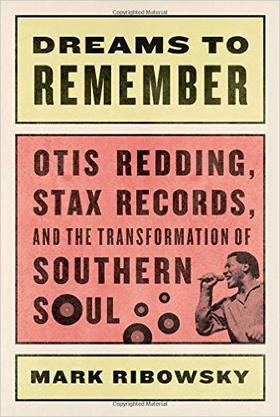Crossing Over: “Dreams to Remember” Book Review

In Dreams to Remember, Mark Ribowsky covers the Otis Redding saga beginning with Redding’s age-fifteen experience singing in the Macon, Ga. clubs with songstress Gladys Williams; moving on to work with showy guitarist Johnny Jenkins; and all-the-while observing the successes of fellow Maconites Little Richard and James Brown.
Soul music was just evolving from the rhythm and blues genre and riding the wave of rock and roll. Otis’ timing was good and his mentors in place, but his life was to be short. This life story is well-researched and documented.
Ribowsky describes Redding’s early 1960s emergence: “Redding had carefully crafted a sturdy, transformative, postmodern epoxy of the bombast of James Brown and Jackie Wilson, the heaving, emotional R&B kick of Ike and Tina Turner, and the shale-smooth gospel pop-soul of Ray Charles and Sam Cooke.”
The heavy sentiment and lyrical excess continues (for the subject is Soul) as Ribowsky builds a case for Otis’ legendary status among the great Soul singers. Aretha cashed in on Otis’ “Respect”—her singing voice is arguably better, but she had no shot at capturing the women’s liberation sympathizers without the great Redding lyrics. And, (Sitting on the) “Dock of the Bay” has no equal in the loneliness and feelings of resignation emotional categories—Otis knew how to craft a song.
In performance, Otis’ charge was to entertain with his body as well as his voice. Physical force was an element in proving a ballad–bending at the hip, and agilely shuffling across the stage while clutching a microphone. There were Elvis and Marvin Gaye, and Otis had the formula down–cool, confident, and smooth. The vocal was his instrument. On stage, he sped up the tempo and used emotional expression to power his message; in the studio Otis produced a subdued, contemplative ballad.
Ribowsky describes the Otis stage presence: “Big, manly, emotional, and full of piss, vinegar, and heart, the man never cheated his audience. Each of his songs was calculated for maximum stage bang. Up there, a three-minute interlude of ‘Fa-fa- fa-fa-fa- (Sad Song),’ ‘Try a Little Tenderness,’ or his riotous cover of ‘Satisfaction’ (Jagger/Richard) were, and still are, like, weightless, free falling emotions unabridged.”
In 1966/1967, Otis was having mixed results on the West Coast, headlining the Whisky-a-Go-Go in Las Angeles and Bill Graham’s Fillmore in San Francisco each for multiple nights. If Otis was to ever take his place in the burgeoning pop/rock music market, the potential presented itself at the Monterey Pop Music Festival during the Summer of Love. This California festival, just 100 miles south of San Francisco, presented challenges to our soul master. Would the hippies and purists accept him? At one a.m. on Saturday night Otis was the last to go on, preceded by Jefferson Airplane, Janis Joplin, and others. Agent Phil Walden was beside himself as he watched Otis light up a joint just before going on. Otis was confident and cool, “I can do this. No problem.”
Otis, the son of a sharecropper/Baptist minister, came out conservatively attired in a suit, although it may have been metallic-colored, with the pants cropped at the ankles in order to show his dance moves. Otis lead off the set with the up-tempo Sam Cooke number “Shake.” He followed that with his composition “Respect,” that he introduced as “a song a women, a friend, took from me as her own.” Otis’ band rhythm section the Mar-Keys, and the Memphis Horns, played the song at twice the usual speed.
The crowd of 100,000 was on their feet dancing—security told Otis he would have to get the crowd to sit on their seats, not stand on them. The band obliged with “I’ve Been Loving You Too Long.” The final tune was “Try a Little Tenderness,” which demanded an encore—an elongated, ad-libbed version of the same; thus ended a thirty-minute set and the evening.
On Sunday, attendees got the Grateful Dead, The Who, and Jimi Hendrix on the schedule. Hendrix was to one-up Pete Townsend that night by pouring lighter fluid on his guitar and igniting it. Where were you then?
Also of note in this book is the ongoing contrast of the Berry Gordy-lead Motown Records mystique and the Jim Stewart/Al Bell label known as Stax Records. Stax was producing sides steeped in soulfulness–Booker T. & the MGs, Otis Redding, Sam and Dave, Eddie Floyd, Carla Thomas, and Isaac Hayes, while the pop-oriented Motown sound was directed primarily toward the white suburban audiences.
The Notes at books-end point to the book titles Otis! The Otis Redding Story by Scott Freeman and Soulsville, U.S.A.: The Story of Stax Records by Rob Bowman as providing valuable source material. Author interviews with Alan Walden (brother Phil was Otis’ lead manager) and aide Alex Hodges of the Walden Agency, Memphis musicians Floyd Newman, Wayne Jackson and Dennis Wheeler, and Stax executive Al Bell provide personal anecdotes adding to the book’s worthiness.
Ribowsky, Mark. Dreams to Remember: Otis Redding, Stax Records, and the Transformation of Southern Soul. Liveright Publishing Corporation: New York. 2015.
Become a Member
Join the growing family of people who believe that music is essential to our community. Your donation supports the work we do, the programs you count on, and the events you enjoy.
Download the App
Download KUVO's FREE app today! The KUVO Public Radio App allows you to take KUVO's music and news with you anywhere, anytime!
